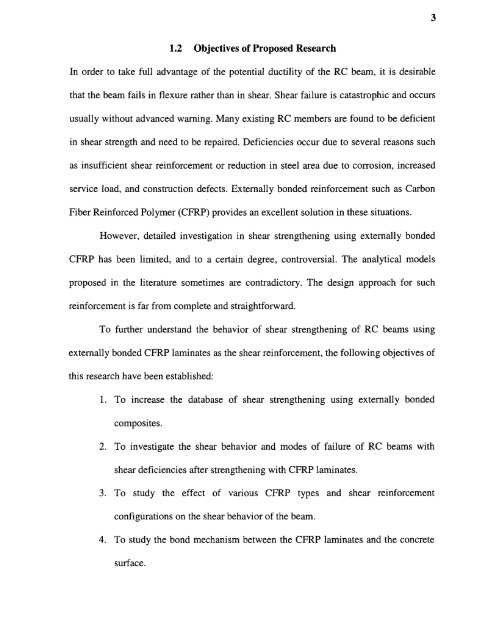njit-etd2003-032 - New Jersey Institute of Technology
njit-etd2003-032 - New Jersey Institute of Technology
njit-etd2003-032 - New Jersey Institute of Technology
You also want an ePaper? Increase the reach of your titles
YUMPU automatically turns print PDFs into web optimized ePapers that Google loves.
3<br />
1.2 Objectives <strong>of</strong> Proposed Research<br />
In order to take full advantage <strong>of</strong> the potential ductility <strong>of</strong> the RC beam, it is desirable<br />
that the beam fails in flexure rather than in shear. Shear failure is catastrophic and occurs<br />
usually without advanced warning. Many existing RO members are found to be deficient<br />
in shear strength and need to be repaired. Deficiencies occur due to several reasons such<br />
as insufficient shear reinforcement or reduction in steel area due to corrosion, increased<br />
service load, and construction defects. Externally bonded reinforcement such as Carbon<br />
Fiber Reinforced Polymer (OFRP) provides an excellent solution in these situations.<br />
However, detailed investigation in shear strengthening using externally bonded<br />
OFRP has been limited, and to a certain degree, controversial. The analytical models<br />
proposed in the literature sometimes are contradictory. The design approach for such<br />
reinforcement is far from complete and straightforward.<br />
To further understand the behavior <strong>of</strong> shear strengthening <strong>of</strong> RO beams using<br />
externally bonded OFRP laminates as the shear reinforcement, the following objectives <strong>of</strong><br />
this research have been established:<br />
1. To increase the database <strong>of</strong> shear strengthening using externally bonded<br />
composites.<br />
2. To investigate the shear behavior and modes <strong>of</strong> failure <strong>of</strong> RO beams with<br />
shear deficiencies after strengthening with CFRP laminates.<br />
3. To study the effect <strong>of</strong> various CFRP types and shear reinforcement<br />
configurations on the shear behavior <strong>of</strong> the beam.<br />
4. To study the bond mechanism between the OFRP laminates and the concrete<br />
surface.

















